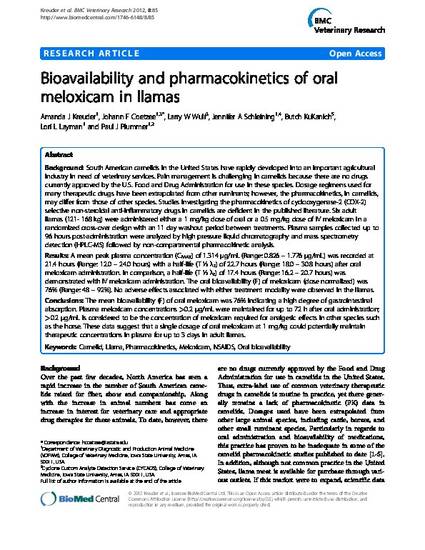
South American camelids in the United States have rapidly developed into an important agricultural industry in need of veterinary services. Pain management is challenging in camelids because there are no drugs currently approved by the U.S. Food and Drug Administration for use in these species. Dosage regimens used for many therapeutic drugs have been extrapolated from other ruminants; however, the pharmacokinetics, in camelids, may differ from those of other species. Studies investigating the pharmacokinetics of cyclooxygenase-2 (COX-2) selective non-steroidal anti-inflammatory drugs in camelids are deficient in the published literature. Six adult llamas (121- 168 kg) were administered either a 1 mg/kg dose of oral or a 0.5 mg/kg dose of IV meloxicam in a randomized cross-over design with an 11 day washout period between treatments. Plasma samples collected up to 96 hours post-administration were analyzed by high pressure liquid chromatography and mass spectrometry detection (HPLC-MS) followed by non-compartmental pharmacokinetic analysis. A mean peak plasma concentration (CMAX) of 1.314 μg/mL (Range: 0.826 – 1.776 μg/mL) was recorded at 21.4 hours (Range: 12.0 – 24.0 hours) with a half-life (T ½ λz) of 22.7 hours (Range: 18.0 – 30.8 hours) after oral meloxicam administration. In comparison, a half-life (T ½ λz) of 17.4 hours (Range: 16.2 – 20.7 hours) was demonstrated with IV meloxicam administration. The oral bioavailability (F) of meloxicam (dose normalized) was 76% (Range: 48 – 92%). No adverse effects associated with either treatment modality were observed in the llamas. The mean bioavailability (F) of oral meloxicam was 76% indicating a high degree of gastrointestinal absorption. Plasma meloxicam concentrations >0.2 μg/mL were maintained for up to 72 h after oral administration; >0.2 μg/mL is considered to be the concentration of meloxicam required for analgesic effects in other species such as the horse. These data suggest that a single dosage of oral meloxicam at 1 mg/kg could potentially maintain therapeutic concentrations in plasma for up to 3 days in adult llamas.
Available at: http://works.bepress.com/paul-plummer/4/

This article is from BMC Veterinary Research 8 (2012): 85, doi:10.1186/1746-6148-8-85. Posted with permission.